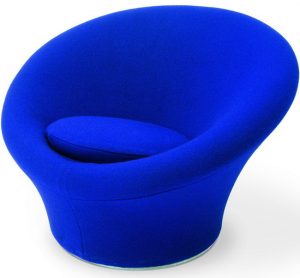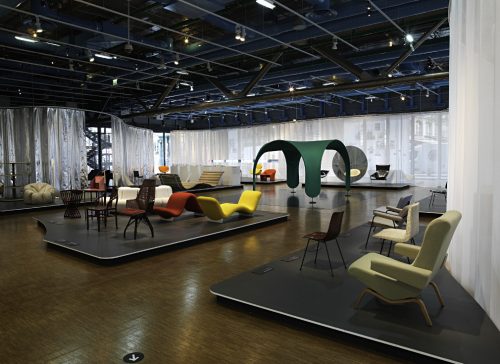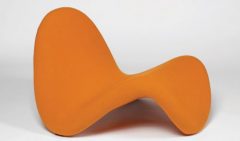
Exhibition:
Centre Pompidou, Paris
MAY 11–AUGUST 22, 2016
Catalogue:
Pierre Paulin
Cloé Pitiot
Paris: Éditions du Centre Pompidou, 2016.
200 pp.; 200 ills.
Paper €34.90
In French only
ISBN 9782844267122
The visual arts no longer enjoy the high status in French public life that they once did. The major museums carry on as before, but their activities are reported mostly in the arts review pages of major newspapers and rarely appear alongside matters of domestic politics and international relations, where they used to enjoy almost equal prominence. It was somewhat unusual, therefore, to see three government ministers at the vernissage of an exhibition at the Centre Pompidou in May of 2016. It was even more surprising to read that the French president, François Hollande, not a politician with a track record in high culture, had requested a private view of the exhibition before it was opened to the public. The exhibition that attracted this high-profile attention was Pierre Paulin, the first retrospective to be devoted to the leading French furniture and interior designer of the second half of the twentieth century. Paulin had close links to the high echelons of power. In the late 1960s he was commissioned by Georges and Claude Pompidou to redesign their private apartments at the Elysée Palace, the president’s residence, and this was repeated in 1984 when François Mitterand, from the rival Socialist Party, went back to Paulin for further designs for these apartments. Paulin’s reputation did not depend on these elevated commissions, however. At a time when most design journals and survey books were following the postwar Italian generation, Paulin was perhaps the only French designer to remain in the game, establishing the largest design studio in the country (ADSA) and producing an impressive range of furniture designs employing bold colors, new materials, and the fluid, seductive forms for which he is best known.
Trained in the Centre d’art et de techniques (the future École Camondo) between 1947 and 1950, Paulin (1927–2009) began to exhibit his first pieces of furniture within two years of graduation. In 1952 he also began working with Meubles TV, a traditional furniture manufacturer that was keen to realign its product lines with a younger, more modern clientele. It was a fortunate alliance between the young designer and the established manufacturer, because Paulin was drawn to the combination of simpler forms and the policy of large-scale production for a mass market. This period produced the first of Paulin’s distinctive chair designs: the Fauteil F273 or “Anneau,” in which a plain-stitched leather seat is suspended within a chromed metal frame. This proved to be a signature combination for Paulin during these early years, and he designed several variations on these basic elements, including the F675 or “Butterfly” chair produced for Artifort in 1963. At the same time, he began collaborating with the engineer Pierre Disderot on a series of lighting designs that carved out a new line for both men. It was this collaboration that helped gain for Paulin the commission to redesign the interior of the Radio France headquarters, a project that attracted a lot of media attention and placed Paulin’s name in the public eye.
In 1958 Paulin began working with the Dutch furniture manufacturer Artifort, thus opening up many opportunities. Like Meubles TV, Artifort was undergoing a radical change of direction under the young Chinese-Indonesian designer Kho Liang Ie, committing the old factory to modern design and production methods while holding on to their supply chains and established network of retail outlets. Paulin took full advantage of the freedom he was offered and embarked upon an entirely new phase in his work. Taking an interest in stretch materials, he turned to swimsuits for inspiration, adapting some of the new acrylic fabrics for upholstery. As he remarked later, these new textiles offered huge potential to rethink the structure, shape, color, and disposition of furniture in the modern interior. To begin with, there was “no need for nails any longer, the covers slipped on like a swimsuit.” Foam rubber was already transforming the furnishing and upholstery industries, but Paulin was more radical than most, using this previously military material for the main substance of the chair, allowing him to “sculpt” abstract forms through the constraints of the outer cover. The form of the chair was thus no longer defined by the structure; in fact, the structure itself was entirely submerged within the monobloc form. This was an important shift in the manufacturing and aesthetics of furniture. Whereas his early designs had broadcast their “revealed construction” of steel frames and simple materials, by the late 1950s Paulin had rejected these values as “old modernity.” The “Mushroom” chair of 1960 (Model 560) is a good example of this shift, and the curator, Cloé Pitiot, has taken pains to demonstrate its originality by displaying the dismantled parts alongside the finished design. The structure is a bold metal frame of intersecting welded steel hoops which has its own abstract beauty, rather as a Rodchenko or Gabo sculpture appeals; yet this was concealed within the stretch material and upholstery that represented the “new modernity” of the 1960s. It was certainly in tune with the times. Over the next two decades, Paulin’s designs for a series of iconic chairs (“Orange Slice,” “Oyster,” “Ribbon,” “Tulip,” and “Groovy,” among several others) helped to define the aesthetics of the pop interior and provided the props for countless photo shoots of models in miniskirts.

In this procession of striking chairs, the “Tongue” chair (577) of 1967 is worth singling out as an example of a further innovation. Not only is the design remarkably simple—apparently just a swoosh of upholstered color, like some graphic logo you can sit on—but it also opens up a number of possibilities for room arrangement and for unusual combinations and storage. Several “Tongues” can be piled comfortably on top of one another to create colorful stacks of arabesques. More significantly, the “Tongue” marked the emergence of Paulin’s interest in the floor as a key element of the modern interior. It was not just the lifestyle choice of “sitting on the floor”; this tendency indicated a range of new possibilities in furniture, textiles, and lighting in which the floor, as well as the walls and ceiling, is included as a surface for experimentation and new uses. For Paulin this was an interesting shift of priorities, not least in the design of furniture that seems to become “carpet-like.” By the same token, floor coverings could be turned up at the edges and corners to become “furniture-like,” or to enclose spaces and demarcate different sections and functions in a room. The “Tapis Siège” (1972) is perhaps the best example here; based on squares and folds, this network of soft upholstered surfaces, originally planned for Herman Miller but abandoned as the firm changed its priorities, could be worked up into a modular system for an entire apartment. One of the most striking pieces, the capacious “La Déclive” of 1968, an undulating couch of upholstered slats that creates an effect like a magic carpet, never went into production.1 Quite apart from the powerful presence this huge piece exerts in a domestic space, it points to a new way of sitting, a new way of relaxing, indeed a new informality that designers of the 1960s and 1970s felt they were bringing into urban society at this time.

The grand hopes and social visions of Paulin’s generation are rarely touched upon in the Pompidou exhibition, which is unfortunate. Like Gaetano Pesce or Mario Bellini (although rarely as radical as they), Paulin was something of a visionary, as indicated by the quotes and information panels that surround the display. But his ideas remain peripheral to the exhibition rather than informing the narrative or underlying ideas. Similarly, the larger questions of style and theory, not least the relationship with the broader movement of postmodernism in the 1970s and 1980s, are not addressed, although a sophisticated designer like Paulin must have been aware of the larger cultural context in which his work was being understood and interpreted. Nor are there many drawings to illuminate his process or studio practice, and his relationship with manufacturers and design agencies of the period remains blank. Only one commission receives closer attention: that for the Elysée Palace, which is revealed through the models that Paulin’s office produced. These miniature versions of the president’s apartments, complete with trial lighting schemes, are a touching reminder of the cheeky pop treatment of historic settings, while revealing a new beauty in the contrast between two radically different epochs. Of the entire suite of rooms, the 1971 smoking room is the most spectacular: a white, tented interior with shielded lighting that serves to enhance the ethereal beauty of the space while also suggesting the enclosed privacy of an igloo or a padded cell. Even here, however, the visitor to the exhibition would have welcomed some photographs of the interiors in use to gain some sense of the space and textures in relation to the occupants. Another question potentially answered by such photographs might be why Paulin should hold such fascination for the highest officers of the French state, while also seeking to create a classless and liberated society by rethinking the furniture and sitting on the floor. This viewer was left with a vision of Georges and Claude Pompidou lounging around in kaftans, while Lyndon and Lady Bird Johnson reclined on the floor—as teenagers of a later decade might say, “it’s not going to happen.”
Charles Parley is a historian and translator based in Barcelona. His primary research is concerned with the Burgundian state in the fifteenth century.

Pierre Paulin, Seat 577, 1967. Centre Pompidou, Musée national d’art modern. Photo: © Bertrand Prévost.
